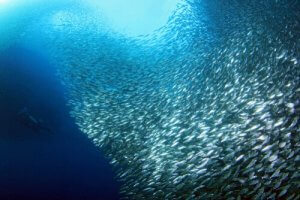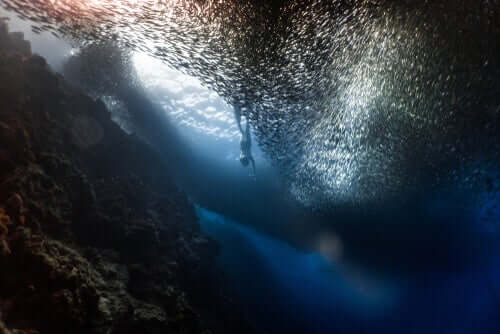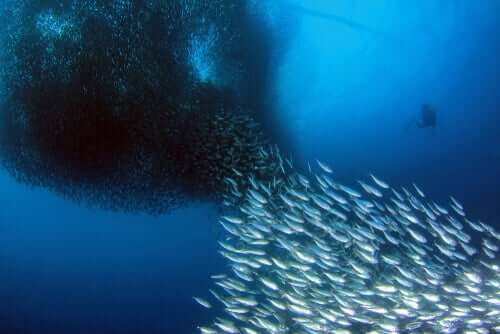The Sardine Run - The Greatest Show on Earth


Written and verified by the biotechnologist Alejandro Rodríguez
The sardine run is a natural phenomenon that’s, indisputably, one of the greatest shows on earth. This migration is the largest one ever recorded in terms of the volume of animals involved in it. Continue reading to find out more about this mass movement of animals.
Are sardines traveling animals?
The animal kingdom is quite extensive and diverse. There are so many species out there and they come in every shape and size. All are well adapted to one type of environment or another. Likewise, there are both sedentary (those who stay in one place) and nomadic animals. Some species of fish are a good example of the latter.
For example, salmon and eel are two species that can easily switch between freshwater and saltwater. However, there are others that can only migrate within one or the other. Some of the species that follow this behavioral pattern are tuna fish and sardines, for instance.
If you go deeper into the sardine group, you’ll discover that the Sardinops sagax is the main player of the sardine run. We’re talking here about their annual migration. This exodus takes place on the coast of South Africa between May and July each year. In fact, estimates reveal that there are billions of them on the move.
The sardine run: why do they do it?

- It’s a phenomenon of seasonal reproductive migration.
- Sardines have a preference for cold waters. Researchers believe there’s a relationship between the displacement of cold bodies of water (from 58 to 68ºF) towards the north of the South African coast and the migration of sardines.
How does a sardine run take place?
Sardines form huge banks or schools in order to move for such long distances. However, this type of grouping is a defense mechanism. This is because the further a sardine gets from the school the bigger its chances of being eaten.
The numbers are overwhelming if we talk in terms of volume. A school is usually about 4 miles long, a mile wide and 98 feet deep. This large volume makes the sardine run visible from ships, and even from planes that fly over the area at such moments.
Obviously, such a large amount of fish doesn’t go unnoticed. This is why many marine species such as dolphins, bull sharks or tiger sharks, and even birds take it as an opportunity to feast. Rather effortlessly, might we add. For example, dolphins corner the sardine bank with the purpose of separating it into smaller groups they can eat.
The volume and concentration of prey reach such magnitude, that it leads to a feeding frenzy. That is, predators go into a state of intense agitation. In fact, they even bite each other at times.
Are there other similar phenomena?
The sardine run is unrivaled in terms of magnitude. However, there’s another terrestrial animal exodus that’s almost as impressive: the wildebeest migration. Each year the circular great migration begins, and over a million animals move across the Mara River, between Kenya and Tanzania.
In addition, there are many other examples of spectacular migrations that travel long, long distances. One of them is the monarch butterfly (Danaus plexippus). These animals travel about 5,000 miles to get from Mexico to the Canadian forests. And, finally, we have the example of the humpback whales (Megaptera novaeangliae), who also migrate up to 5000 miles each year.
The sardine run is a natural phenomenon that’s, indisputably, one of the greatest shows on earth. This migration is the largest one ever recorded in terms of the volume of animals involved in it. Continue reading to find out more about this mass movement of animals.
Are sardines traveling animals?
The animal kingdom is quite extensive and diverse. There are so many species out there and they come in every shape and size. All are well adapted to one type of environment or another. Likewise, there are both sedentary (those who stay in one place) and nomadic animals. Some species of fish are a good example of the latter.
For example, salmon and eel are two species that can easily switch between freshwater and saltwater. However, there are others that can only migrate within one or the other. Some of the species that follow this behavioral pattern are tuna fish and sardines, for instance.
If you go deeper into the sardine group, you’ll discover that the Sardinops sagax is the main player of the sardine run. We’re talking here about their annual migration. This exodus takes place on the coast of South Africa between May and July each year. In fact, estimates reveal that there are billions of them on the move.
The sardine run: why do they do it?

- It’s a phenomenon of seasonal reproductive migration.
- Sardines have a preference for cold waters. Researchers believe there’s a relationship between the displacement of cold bodies of water (from 58 to 68ºF) towards the north of the South African coast and the migration of sardines.
How does a sardine run take place?
Sardines form huge banks or schools in order to move for such long distances. However, this type of grouping is a defense mechanism. This is because the further a sardine gets from the school the bigger its chances of being eaten.
The numbers are overwhelming if we talk in terms of volume. A school is usually about 4 miles long, a mile wide and 98 feet deep. This large volume makes the sardine run visible from ships, and even from planes that fly over the area at such moments.
Obviously, such a large amount of fish doesn’t go unnoticed. This is why many marine species such as dolphins, bull sharks or tiger sharks, and even birds take it as an opportunity to feast. Rather effortlessly, might we add. For example, dolphins corner the sardine bank with the purpose of separating it into smaller groups they can eat.
The volume and concentration of prey reach such magnitude, that it leads to a feeding frenzy. That is, predators go into a state of intense agitation. In fact, they even bite each other at times.
Are there other similar phenomena?
The sardine run is unrivaled in terms of magnitude. However, there’s another terrestrial animal exodus that’s almost as impressive: the wildebeest migration. Each year the circular great migration begins, and over a million animals move across the Mara River, between Kenya and Tanzania.
In addition, there are many other examples of spectacular migrations that travel long, long distances. One of them is the monarch butterfly (Danaus plexippus). These animals travel about 5,000 miles to get from Mexico to the Canadian forests. And, finally, we have the example of the humpback whales (Megaptera novaeangliae), who also migrate up to 5000 miles each year.
All cited sources were thoroughly reviewed by our team to ensure their quality, reliability, currency, and validity. The bibliography of this article was considered reliable and of academic or scientific accuracy.
- Fréon, P., Coetzee, J. C., Van der Lingen, C. D., Connell, A. D., O’Donoghue, S. H., Roberts, M. J., … & Hutchings, L. (2010). A review and tests of hypotheses about causes of the KwaZulu-Natal sardine run. African Journal of Marine Science, 32(2), 449-479.
- Van Der Lingen, C. D., Coetzee, J. C., & Hutchings, L. (2010). Overview of the KwaZulu-Natal sardine run. African Journal of Marine Science, 32(2), 271-277.
This text is provided for informational purposes only and does not replace consultation with a professional. If in doubt, consult your specialist.








